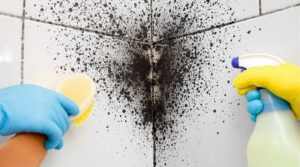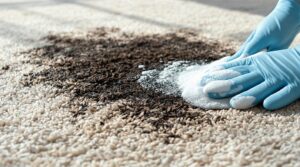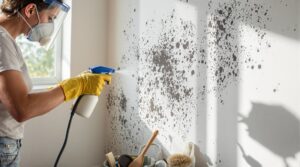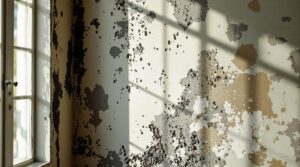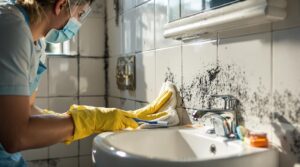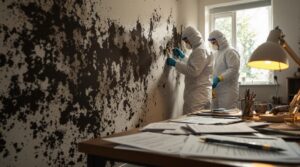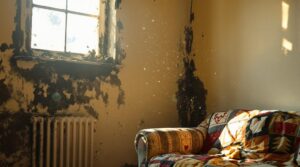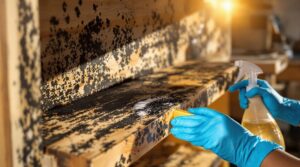To eliminate black mold in air vents, turn off the HVAC system and vacuum loose particles before applying a cleaning solution. A bleach solution or vinegar and water mixture can be used to target affected areas. For larger infestations or health concerns, consider hiring a professional mold removal service. Regular HVAC maintenance, proper ventilation, and controlling humidity levels below 50% can prevent future mold growth. Further guidance can provide a thorough approach to mold removal and prevention.
Key Takeaways
- Turn off the HVAC system to prevent mold spores from spreading before cleaning the air vents.
- Vacuum loose particles with a HEPA vacuum to capture mold spores and prevent further growth.
- Apply a bleach solution (1 part bleach to 16 parts water) or a vinegar and water solution to moldy areas.
- Create a paste of baking soda and water for direct application on visible mold, scrub gently, and wipe clean.
- For areas larger than 10 square feet, consider hiring a professional mold removal service for effective remediation.
Removing Mold From Air Vents
When tackling the task of removing mold from air vents, it is essential to begin by turning off the HVAC system to prevent mold spores from circulating and spreading to other areas during the cleaning process.
Next, vacuum loose particles and apply a solution of one part bleach to sixteen parts water to the moldy areas using a rag. This effectively kills the mold present. Alternatively, a solution of equal parts vinegar and water can be sprayed on the mold and allowed to sit for an hour before wiping.
To prevent mold growth, it is vital to regularly change air filters every 1-3 months, trapping spores and maintaining good air quality.
Professional mold removal services are recommended for extensive infestations, as they possess the necessary tools and expertise to safely and thoroughly address hidden mold issues in air ducts, ensuring effective mold removal and preventing potential health problems.
For thorough cleaning, maintain negative air pressure of at least -5 Pascals during the remediation process to prevent mold spores from escaping the work area.
Identifying and Addressing Moisture Sources
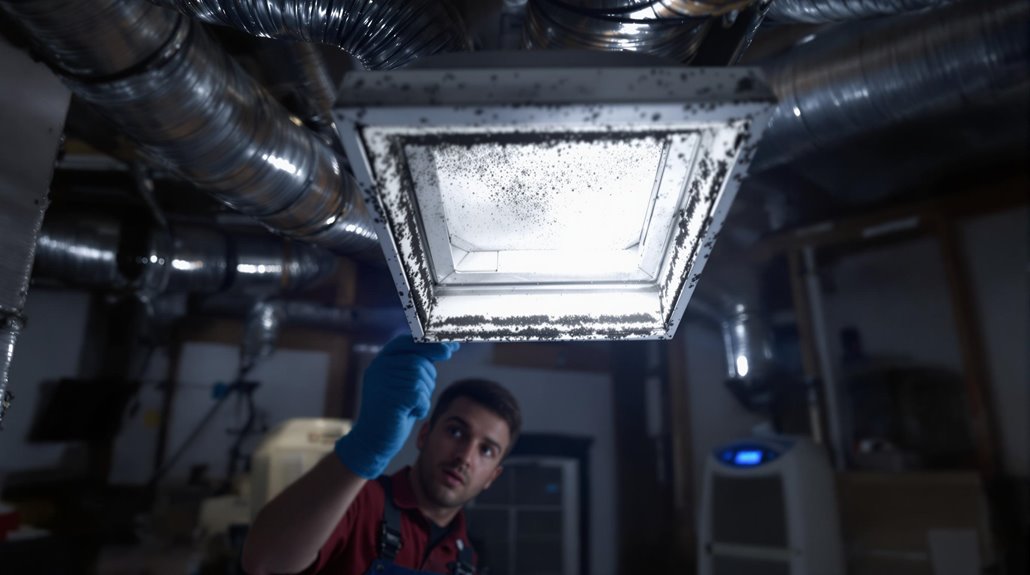
In addition to removing mold from air vents, addressing the underlying moisture sources is crucial to preventing future mold growth. High indoor humidity levels above 60% create a conducive environment for mold growth, emphasizing the need for humidity control measures such as dehumidifiers.
Leaks in the HVAC system, particularly in ducts or from condensation in poorly insulated areas, should be identified and repaired. Regular inspections are essential to mitigate moisture introduction. Poor ventilation can lead to stagnant air pockets that trap humidity, underlining the importance of ensuring proper airflow throughout the home.
Clogged or dirty air filters can also trap moisture and organic debris, supporting mold growth. Filters should be changed every 1-3 months to maintain ideal airflow and moisture control.
DIY Methods for Eliminating Black Mold
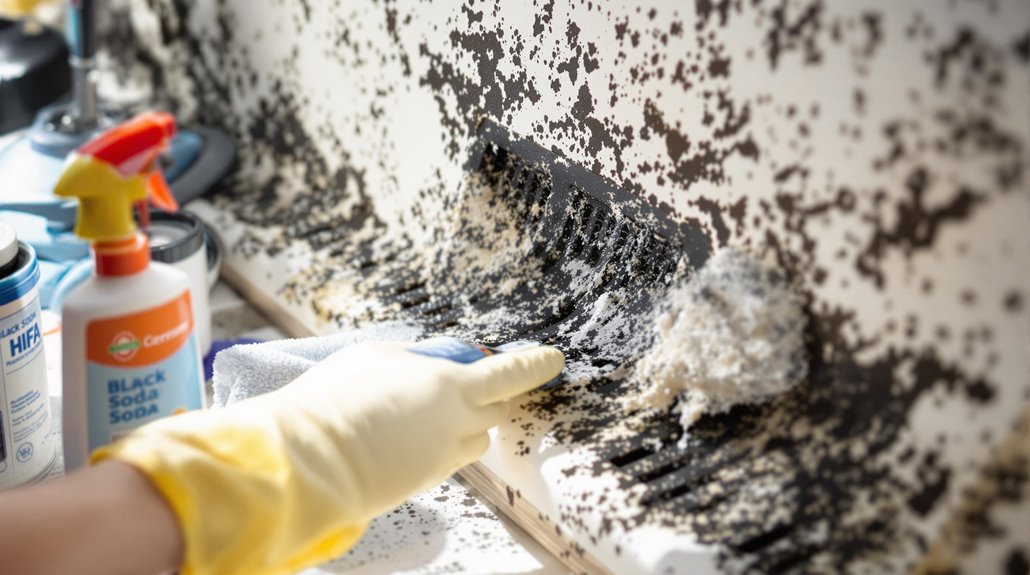
Addressing moisture sources is only the first step in eradicating black mold from air vents.
To guarantee clean air and a mold-free environment, it's vital to employ effective DIY methods for eliminating black mold.
Capturing mold spores during remediation is fundamental to preventing their spread.
The following measures can be taken to contain and eliminate mold:
- Utilize a HEPA vacuum: Capture and contain mold spores when cleaning easily accessible duct components and vents.
- Use targeted cleaning solutions: Apply a bleach solution to non-porous surfaces or a vinegar solution to affected areas to kill mold spores.
- Direct paste application: Apply a paste made from baking soda and water directly onto visible mold, scrub gently, and wipe clean to absorb moisture and odors.
For areas larger than 10 square feet, professional remediation services should be contacted immediately.
Implementing these methods can help solve the moisture problem and remove black mold in air vents, ultimately promoting mold remediation and maintaining clean air.
When to Hire a Professional Mold Removal Service
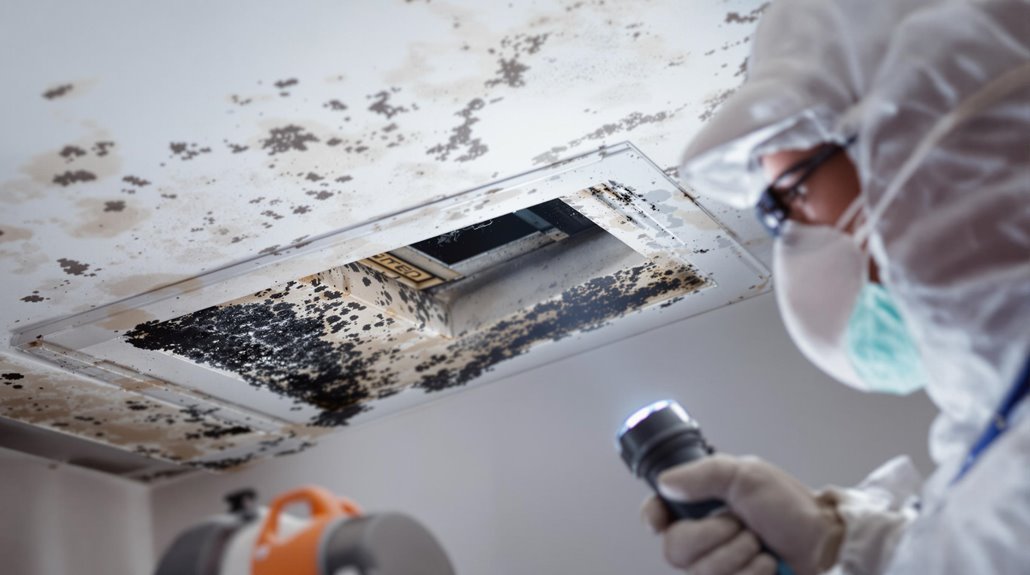
How effectively can DIY methods truly manage widespread mold infestations in air vents? In reality, they often fall short, particularly when dealing with extensive mold problems.
In such cases, hiring a professional mold removal service is vital. These experts possess the necessary tools and expertise to effectively manage large-scale infestations, including those that have spread to mold in the ductwork.
If health issues persist due to mold exposure, seeking professional help is imperative. A professional mold removal service can perform thorough inspections to identify hidden mold and moisture sources, providing solutions that may not be apparent to untrained individuals.
They employ advanced cleaning equipment and proper containment measures to minimize the risk of mold spores spreading during removal. Additionally, they can utilize specialized mold-killing agents to guarantee thorough remediation.
Professional remediation experts maintain indoor humidity levels between 30-50% to prevent future mold growth.
Preventing Future Mold Growth in Air Vents
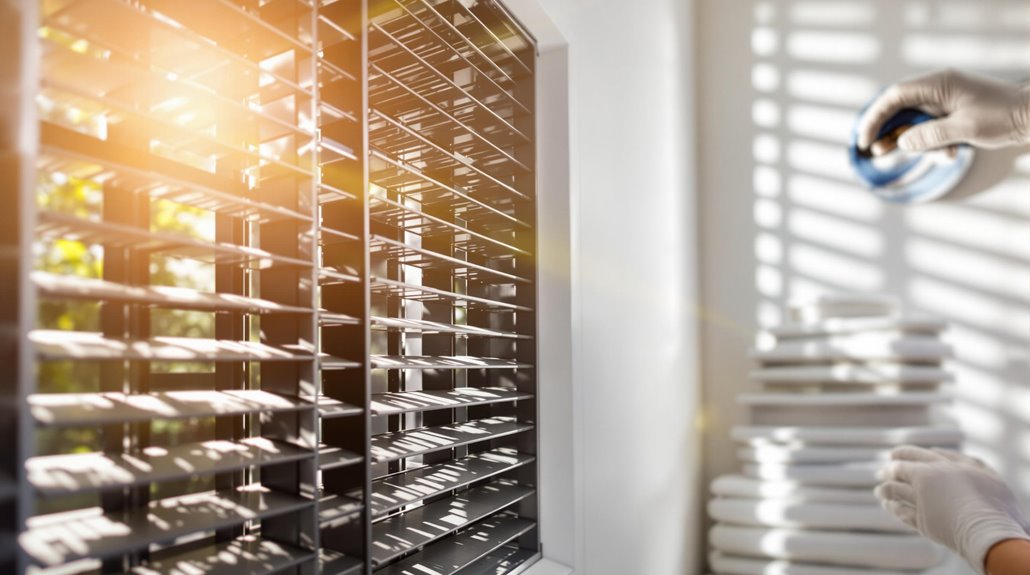
While professional mold removal services can effectively eliminate existing mold infestations in air vents, preventing future growth is vital to maintaining a healthy indoor environment.
To prevent mold growth in air vents, it is important to control humidity levels, maintain a clean HVAC system, and eliminate mold spores.
The following measures can help prevent mold growth in air vents:
- Maintain humidity levels below 50% by utilizing dehumidifiers and ensuring adequate ventilation to inhibit mold growth conditions.
- Change air filters every 1-3 months to effectively trap mold spores and prevent them from circulating throughout the HVAC system.
- Schedule regular HVAC maintenance every 2-3 years to keep the system clean and address potential moisture issues before they become mold problems.
The Benefits Of Consulting A Public Adjuster

In the event of mold-related property damage, consulting a public adjuster can provide policyholders with expertise in insurance claims, ensuring a thorough understanding of their entitlements.
A public adjuster's objective damage assessment capabilities also enable accurate evaluations of losses, which can be critical in determining fair compensation.
Expertise In Insurance Claims
Steering through the complexities of insurance claims for black mold damage in air vents can be an intimidating task for homeowners, but consulting a public adjuster can greatly simplify the process.
Public adjusters possess expertise in understanding policy coverage, exclusions, and limits, leading to better negotiation outcomes and preventing underpayment or denial of claims.
Key benefits of hiring a public adjuster include:
- Accurate damage assessment: Public adjusters accurately assess the extent of the mold problem, ensuring proper documentation is provided to insurers.
- Maximized claim value: Public adjusters are incentivized to maximize the claim value, potentially resulting in a higher payout.
- Expedited claims process: Public adjusters handle communication with the insurance company, allowing homeowners to focus on remediation efforts and addressing health effects, such as respiratory issues.
Working on a contingency basis means public adjusters only receive payment when they successfully secure a settlement for your claim.
Objective Damage Assessment
As claims for black mold damage in air vents can be notoriously complex, consulting a public adjuster can provide an important advantage in securing a fair settlement.
A public adjuster provides an objective assessment of the damage, guaranteeing that all affected areas are documented accurately for insurance claims. This includes identifying hidden mold in ductwork that may not be visible during a standard inspection.
With expertise in evaluating mold damage, public adjusters can negotiate with insurance companies to cover the costs of mold remediation and repairs. They manage the claims process, provide guidance on necessary documentation, and guarantee compliance with local laws, maximizing claim potential for homeowners.
This objective assessment is vital in securing a fair settlement for mold damage claims.
Public adjusters can increase settlements by up to 500% for non-catastrophe claims through their professional expertise and thorough documentation processes.
Streamlined Claim Process
Numerous benefits can be realized by homeowners who consult a public adjuster to handle mold damage claims, particularly in relation to streamlining the claim process.
By hiring a public adjuster, homeowners can guarantee a thorough assessment of mold damage, accurate documentation of losses, and effective negotiation with insurance companies to cover remediation costs.
The following benefits of a streamlined claims process can be achieved by consulting a public adjuster:
- Efficient Communication: A public adjuster handles all communication with insurance companies, allowing homeowners to focus on recovery from mold damage.
- Expert Policy Knowledge: They provide expert knowledge of policy language and coverage, maximizing the claim to cover necessary mold remediation costs.
- Accurate Documentation: Public adjusters document losses with detailed reports and photographs, supporting the claim and facilitating homeowner recovery.
With standard coverage limits ranging from mold coverage limits of $1,000 to $10,000 per occurrence, having a public adjuster ensures you receive the maximum compensation available under your policy.
Higher Claim Payouts & Settlements
Insurance claims for mold damage can be complex and often result in lower payouts if not properly navigated. Consulting a public adjuster can greatly influence the outcome of a claim, leading to higher claim payouts and settlements. Public adjusters are experts in insurance policies, able to identify coverage that may not be immediately apparent, thereby maximizing claim value. Professional mold testing is required to support claims with proper documentation and evidence linking damage to covered perils.
| Benefits of Public Adjusters | Impact on Policyholders | Statistics |
|---|---|---|
| Accurate damage assessment | Saves time, reduces stress | 20-50% higher settlements |
| Thorough documentation | Maximizes claim value, guarantees fair payout | Contingency fee basis |
| Expertise in insurance policies | Guarantees alignment with policyholder goals | Increased settlement amounts |
About The Public Claims Adjusters Network (PCAN)
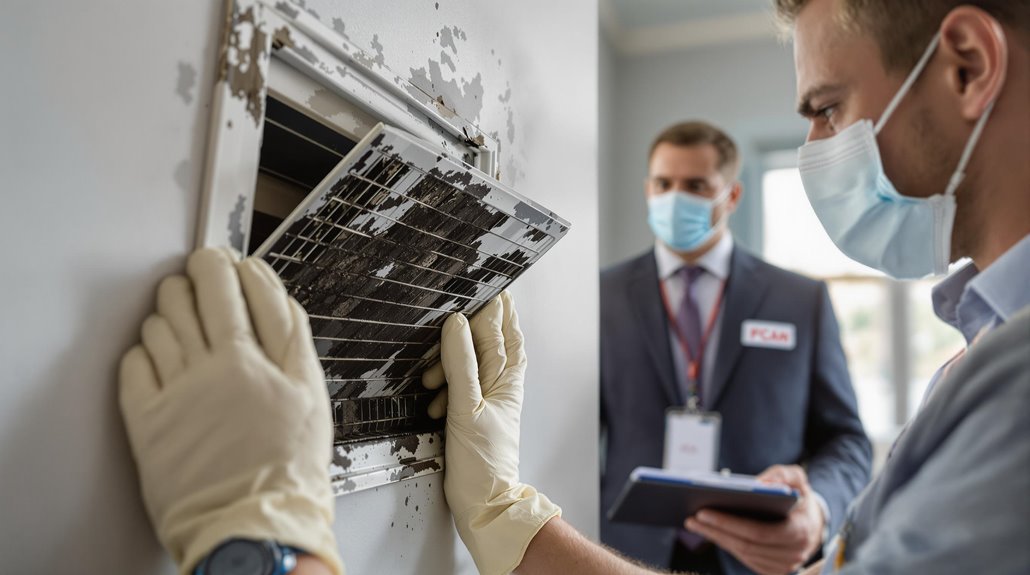
The Public Claims Adjusters Network (PCAN) is a nationwide organization comprising highly qualified public adjusters who specialize in managing residential and commercial property damage insurance claims.
PCAN serves as a resource for policyholders to connect with expert public adjusters who are pre-vetted, licensed, and experts in their field.
The following key aspects of PCAN guarantee the highest standards of service:
- Rigorous Screening Process: Member adjusters undergo an intensive application and interview process to guarantee expertise and professionalism.
- Yearly Audits: Mandatory audits of licenses and complaints are conducted to maintain the highest standards of ethics and morals.
- Nationwide Coverage: PCAN member adjusters cover over 30 different claim types and are located in 40+ states, providing thorough support to policyholders.
Frequently Asked Questions
How to Get Black Mold Out of Air Vents?
Effective air duct cleaning involves utilizing mold removal tips, incorporating preventive measures, and implementing ventilation maintenance. Utilize cleaning supplies, consider professional services, control humidity, and employ DIY solutions to mitigate mold growth causes and associated health risks.
What Can I Spray in My Air Ducts to Kill Mold?
When mold rears its ugly head, an ounce of prevention is worth a pound of cure; mold removal solutions like vinegar, hydrogen peroxide, tea tree oil, and commercial EPA-approved sprays can effectively tackle air duct mold, preventing health risks.
Can Black Mold in Vents Make You Sick?
Black mold in vents poses significant health risks, triggering mold exposure-related respiratory issues, allergy symptoms, and immune response problems, including chronic fatigue, skin irritations, asthma attacks, sinus infections, and potential long-term cognitive effects.
Can I Clean My Air Ducts Myself?
Individuals can perform DIY duct cleaning to improve air quality, incorporating mold prevention tips and proper ventilation system maintenance, but extensive infestations require professional cleaning services and duct inspection techniques for common mold types.
